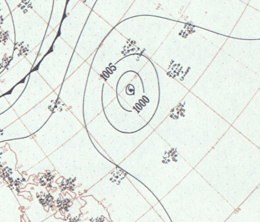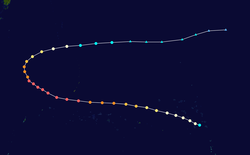1952 Pacific typhoon season
The 1952 Pacific typhoon season had no official bounds, but most tropical cyclones tend to form in the northwestern Pacific Ocean between June and December. These dates conventionally delimit the period of each year when most tropical cyclones form in the northwestern Pacific Ocean.
| 1952 Pacific typhoon season | |
|---|---|
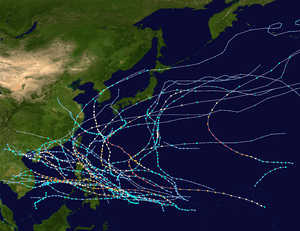 Season summary map | |
| Seasonal boundaries | |
| First system formed | May 5, 1952 |
| Last system dissipated | January 4, 1953 |
| Strongest storm | |
| Name | Wilma |
| • Maximum winds | 295 km/h (185 mph) (10-minute sustained) |
| • Lowest pressure | 914 hPa (mbar) |
| Seasonal statistics | |
| Total storms | 29 |
| Typhoons | 20 |
| Super typhoons | 6 (unofficial) |
| Total fatalities | 1,070 |
| Total damage | Unknown |
| Related articles | |
The scope of this article is limited to the Pacific Ocean, north of the equator and west of the international date line. Storms that form east of the date line and north of the equator are called hurricanes; see 1952 Pacific hurricane season. Tropical Storms formed in the entire west Pacific basin were assigned a name by the Fleet Weather Center on Guam.
Season summary

Systems
Typhoon Charlotte
| Category 2 typhoon (SSHWS) | |
 | |
| Duration | June 10 – June 15 |
|---|---|
| Peak intensity | 155 km/h (100 mph) (1-min) 960 hPa (mbar) |
Typhoon Dinah
| Category 1 typhoon (SSHWS) | |
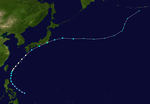 | |
| Duration | June 19 – June 25 |
|---|---|
| Peak intensity | 140 km/h (85 mph) (1-min) 960 hPa (mbar) |
On June 23, Dinah struck to the west of the Kanto Region in Japan. 65 people were killed and 70 were missing.[1]
Typhoon Emma
| Category 3 typhoon (SSHWS) | |
 | |
| Duration | June 28 – July 6 |
|---|---|
| Peak intensity | 205 km/h (125 mph) (1-min) 975 hPa (mbar) |
Tropical Storm Freda
| Tropical storm (SSHWS) | |
 | |
| Duration | July 11 – July 15 |
|---|---|
| Peak intensity | 85 km/h (50 mph) (1-min) 995 hPa (mbar) |
Tropical Storm Gilda
| Tropical storm (SSHWS) | |
 | |
| Duration | July 15 – July 20 |
|---|---|
| Peak intensity | 95 km/h (60 mph) (1-min) 990 hPa (mbar) |
Typhoon Harriet
| Category 3 typhoon (SSHWS) | |
 | |
| Duration | July 26 – July 30 |
|---|---|
| Peak intensity | 185 km/h (115 mph) (1-min) 980 hPa (mbar) |
Tropical Storm Ivy
| Tropical storm (SSHWS) | |
 | |
| Duration | August 2 – August 8 |
|---|---|
| Peak intensity | 85 km/h (50 mph) (1-min) 990 hPa (mbar) |
Tropical Storm Jeanne
| Tropical storm (SSHWS) | |
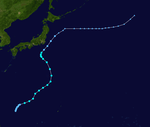 | |
| Duration | August 4 – August 7 |
|---|---|
| Peak intensity | 75 km/h (45 mph) (1-min) 985 hPa (mbar) |
Typhoon Karen
| Category 2 typhoon (SSHWS) | |
 | |
| Duration | August 10 – August 20 |
|---|---|
| Peak intensity | 155 km/h (100 mph) (1-min) 955 hPa (mbar) |
Typhoon Lois
| Category 1 typhoon (SSHWS) | |
 | |
| Duration | August 22 – August 30 |
|---|---|
| Peak intensity | 140 km/h (85 mph) (1-min) 975 hPa (mbar) |
Typhoon Mary
| Category 1 typhoon (SSHWS) | |
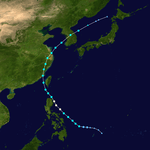 | |
| Duration | August 29 – September 4 |
|---|---|
| Peak intensity | 120 km/h (75 mph) (1-min) 985 hPa (mbar) |
Typhoon Nona
| Category 1 typhoon (SSHWS) | |
 | |
| Duration | September 2 – September 8 |
|---|---|
| Peak intensity | 150 km/h (90 mph) (1-min) 980 hPa (mbar) |
Tropical Storm 12W
| Tropical storm (SSHWS) | |
 | |
| Duration | September 7 – September 14 |
|---|---|
| Peak intensity | 75 km/h (45 mph) (1-min) 995 hPa (mbar) |
Super Typhoon Olive
| Category 5 super typhoon (SSHWS) | |
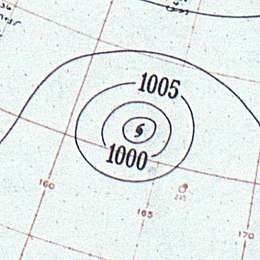 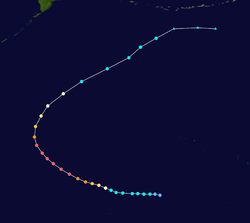 | |
| Duration | September 13 – September 21 |
|---|---|
| Peak intensity | 295 km/h (185 mph) (1-min) 940 hPa (mbar) |
Tropical Storm 14W
| Tropical storm (SSHWS) | |
 | |
| Duration | September 16 – September 19 |
|---|---|
| Peak intensity | 65 km/h (40 mph) (1-min) 996 hPa (mbar) |
Typhoon Polly
| Category 1 typhoon (SSHWS) | |
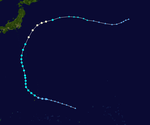 | |
| Duration | September 26 – October 3 |
|---|---|
| Peak intensity | 130 km/h (80 mph) (1-min) 975 hPa (mbar) |
Typhoon Rose
| Category 1 typhoon (SSHWS) | |
 | |
| Duration | October 4 – October 10 |
|---|---|
| Peak intensity | 150 km/h (90 mph) (1-min) 985 hPa (mbar) |
Tropical Storm Shirley
| Tropical storm (SSHWS) | |
 | |
| Duration | October 14 – October 15 |
|---|---|
| Peak intensity | 75 km/h (45 mph) (1-min) 995 hPa (mbar) |
Typhoon Trix
| Category 4 typhoon (SSHWS) | |
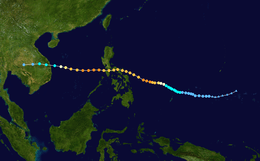 | |
| Duration | October 15 – October 26 |
|---|---|
| Peak intensity | 220 km/h (140 mph) (1-min) 965 hPa (mbar) |
Typhoon Trix struck the Philippines as a Category 3 typhoon. It struck the Bicol region, killing 995 people.[2]
Typhoon Vae
| Category 1 typhoon (SSHWS) | |
 | |
| Duration | October 17 – October 20 |
|---|---|
| Peak intensity | 120 km/h (75 mph) (1-min) 974 hPa (mbar) |
Super Typhoon Wilma
| Category 5 super typhoon (SSHWS) | |
 | |
| Duration | October 21 – October 31 |
|---|---|
| Peak intensity | 295 km/h (185 mph) (1-min) 914 hPa (mbar) |
On October 26, ten people were lost when a USAF WB-29 disappeared during a flight into Super Typhoon Wilma.[3]
Super Typhoon Agnes
| Category 5 super typhoon (SSHWS) | |
 | |
| Duration | October 28 – November 7 |
|---|---|
| Peak intensity | 280 km/h (175 mph) (1-min) 920 hPa (mbar) |
Typhoon Bess
| Category 3 typhoon (SSHWS) | |
 | |
| Duration | November 9 – November 16 |
|---|---|
| Peak intensity | 185 km/h (115 mph) (1-min) 915 hPa (mbar) |
Typhoon Carmen
| Category 3 typhoon (SSHWS) | |
 | |
| Duration | November 15 – November 22 |
|---|---|
| Peak intensity | 205 km/h (125 mph) (1-min) 950 hPa (mbar) |
Super Typhoon Della
| Category 5 super typhoon (SSHWS) | |
 | |
| Duration | November 22 – November 27 |
|---|---|
| Peak intensity | 280 km/h (175 mph) (1-min) 930 hPa (mbar) |
Tropical Storm Elaine
| Tropical storm (SSHWS) | |
 | |
| Duration | December 4 – December 6 |
|---|---|
| Peak intensity | 85 km/h (50 mph) (1-min) 990 hPa (mbar) |
Tropical Storm Faye
| Tropical storm (SSHWS) | |
 | |
| Duration | December 16 – December 19 |
|---|---|
| Peak intensity | 85 km/h (50 mph) (1-min) 990 hPa (mbar) |
Storm names
|
|
|
See also
- 1952 Pacific hurricane season
- 1952 Atlantic hurricane season
- Pre-1980 North Indian Ocean cyclone seasons
References
- Digital Typhoon: Disaster Information
- "::..Typhoon2000.com: 30 Worst Typhoons of the Philippines (1947-2002)..::". Archived from the original on 2009-03-17. Retrieved 2015-06-09.
- Deadly Hurricane Hunter Flights

